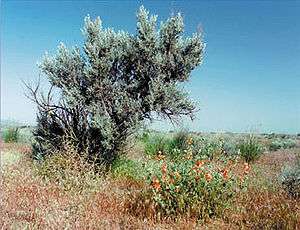Shrub-steppe
Shrub-steppe is a type of low-rainfall natural grassland. While arid, shrub-steppes have sufficient moisture to support a cover of perennial grasses or shrubs, a feature which distinguishes them from deserts.
The primary ecological processes historically at work in shrub-steppe ecosystems are drought and fire. Shrub-steppe plant species have developed particular adaptations to low annual precipitation and summer drought conditions. Plant adaptations to different soil moisture regimes influence their distribution. A frequent fire regime in the shrub-steppe similarly adds to the patchwork pattern of shrub and grass that characterizes shrub steppe ecosystems.[1]
North America


The shrub-steppes of North America occur in the western United States and western Canada, in the rain shadow between the Cascades and Sierra Nevada on the west and the Rocky Mountains on the east. They extend from south-central British Columbia down into southeastern Washington, eastern Oregon, and eastern California, and across through Idaho, Nevada, and Utah into western Wyoming and Colorado, and down into northern and central New Mexico and northern Arizona. Growth is dominated primarily by low-lying shrubs, such as big sagebrush (Artemisia tridentata) and bitterbrush (Purshia tridentata), with too little rainfall to support the growth of forests, though some trees do occur. Other important plants are bunchgrasses such as Pseudoroegneria spicata, which have historically provided forage for livestock as well as wildlife, but are quickly being replaced by nonnative annual species like cheatgrass (Bromus tectorum), tumble mustard (Sisymbrium altissimum), and Russian thistle (Salsola kali). There is also a suite of animals that call the shrub-steppe home, including sage grouse, pygmy rabbit, Western rattlesnake, and pronghorn.
Historically, much of the shrub-steppe in the state of Washington was referred to as "scabland" because of the deep channels cut into pure basalt rock by cataclysmic floods more than 10,000 years ago (see Channeled Scablands). Major threats to the ecosystem include overgrazing, fires, invasion by nonnative species, development (since much of it is at lower elevations), conversion to cropland, and energy development. Less than 50% of the state of Washington's historic shrub-steppe remains[2]; according to some estimates, only 12 to 15% remains.[3]
Shrub-steppe ecoregions of North America include:
- Great Basin shrub steppe in eastern California, central Nevada, western Utah, and southeastern Idaho.[4]
- Snake–Columbia shrub steppe in south-central Washington state, eastern Oregon, northeastern California, northern Nevada, and Idaho.[5]
- Wyoming Basin shrub steppe in central Wyoming, reaching into south-central Montana, northeastern Utah, southwestern Idaho, and northwestern Colorado.[6]
- Okanagan shrub steppe in the Okanagan Valley in south-central British Columbia, and the southern Similkameen Valley in south-central British Columbia and north-central Washington state.
References
- "Shrub-Steppe Ecosystem". Ecosystems. Washington Native Plant Society.
- "Shrubsteppe Ecology". Washington Department of Fish and Wildlife.
- "Threats to the Shrub-Steppe". Washington Native Plant Society.
- "Great Basin shrub steppe". Terrestrial Ecoregions. World Wildlife Fund.
- "Snake-Columbia shrub steppe". Terrestrial Ecoregions. World Wildlife Fund.
- "Wyoming Basin shrub steppe". Terrestrial Ecoregions. World Wildlife Fund.
See also
- Arid Lands Ecology Reserve (in Washington state in the US)
- Artemisia tridentata
- Deserts and xeric shrublands
- Rangeland
- Sagebrush steppe
- Temperate grasslands, savannas, and shrublands
- Steppe
